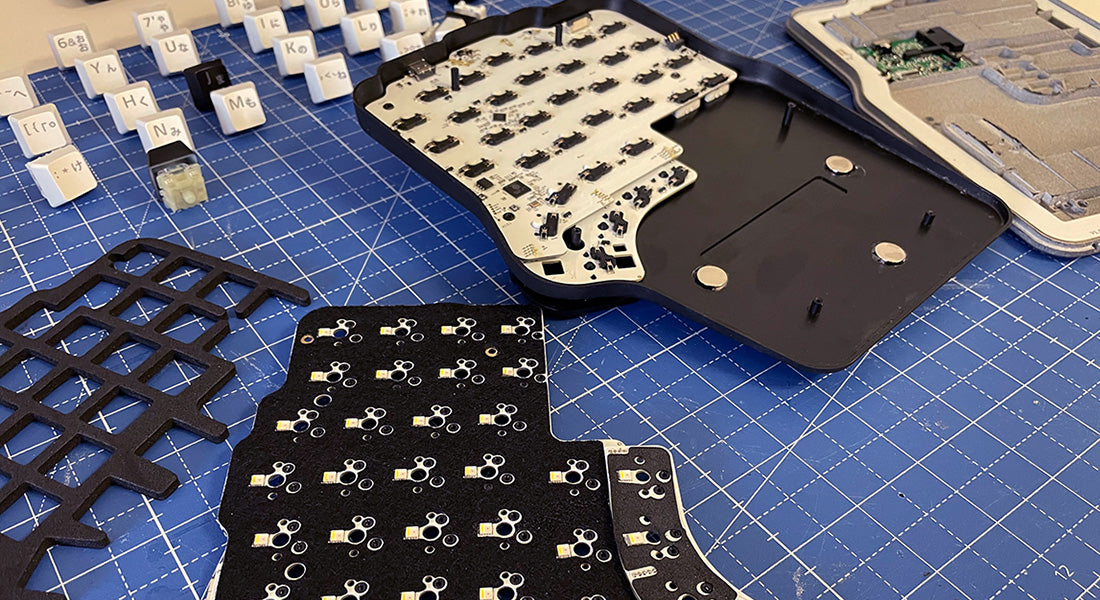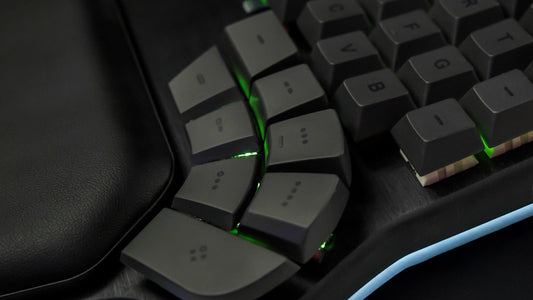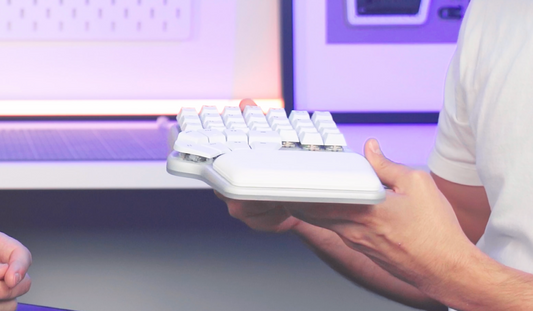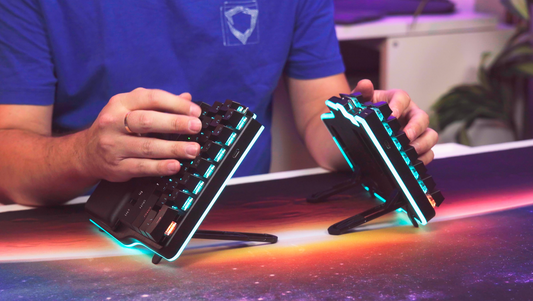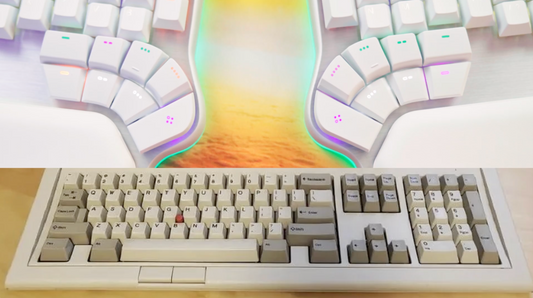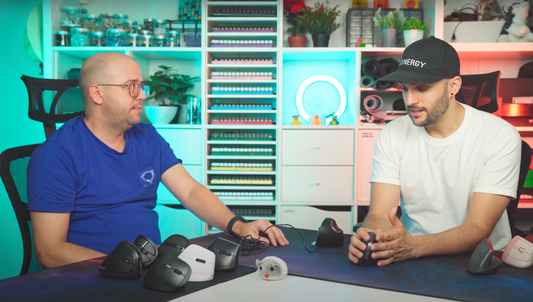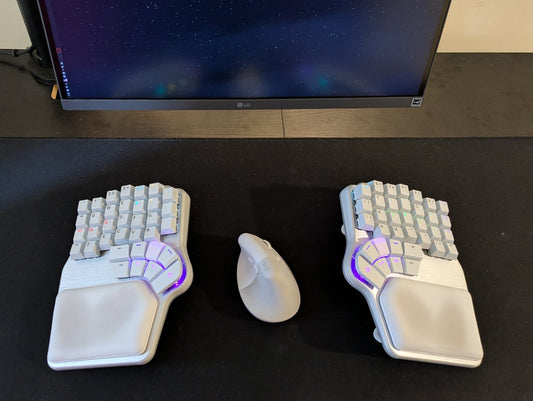Now that the Kickstarter campaign is over and you’ve all chosen and configured your Defy (if you haven’t, please email us at contact@dygma.com), it’s a great moment to take a look at how the Defy is coming together 👀
The product team has been working non-stop since long before the campaign started, and we’re now moving into manufacturing, which is easier said than done 😅
With so many configuration options, the Dygma Defy is eight different keyboards from a mechanical standpoint. You can get it without add-ons, with all three, and with six other combinations of wireless, tenting, and underglow.
And that’s not considering colors, switches, and keycaps. Those take the possible combinations to up to 6048. With around 2500 backers, there’s a good chance your keyboard is one of a kind, which is a nightmare from an operations and manufacturing standpoint great.
The challenge is that to offer such customization options while meeting the minimum order quantities, we need to make the final assembly “on demand” here in Spain. It also means that each part must be compatible with the possible combinations 🧩
On top of that, the Dygma Defy is three different keyboards from the electronics and firmware perspective: wired, RF, and Bluetooth.
Fortunately, we have a great team of engineers and developers who put all their knowledge to work. And thanks to them, we’re making steady progress 💪
We’ll dive into great detail in this update, so be prepared. But if you don’t have time to read too much, here’s a summary:
- Mechanical: It’s moving forward as planned. We’re receiving the samples of all the components from the factories. Now, we must assemble them, test them and make the necessary adjustments.
- Electronics & firmware: We hit a big milestone: the wired Defy passed the CE pre-certification test on its first try. This is huge, as it’s something that took months with our first keyboard, the Raise. The wireless Defy is moving forward, too –the RF version sends keystrokes, and Bluetooth has a stable connection– but we hit a couple of roadblocks that made us use three weeks of the “buffer” we have in our planning.
- Software: This is the easiest part, as our software is already used by thousands of Raise users. However, we’re working on a new version with a better UI & UX, of which we’re about to release Beta 15. The final version will be ready before the Defy ships.
Mechanical
Right now, it’s Christmas at the office. At least for the product team.
Every day they open packages that come from afar 🎁
Let’s check what they got:
Aluminum top panel
We’ve just received the first sample of the aluminum top panel, which is quite a massive milestone for us 🎉
We’ve had to work with our supplier to configure all the manufacturing processes to reach this point. That process is responsible for giving the top panel its shape and finish and creating the holes for the switches and all the necessary recesses on the surface.

The top panel is one of the critical pieces we were waiting for. This way, we can assemble a test keyboard and check how everything fits together, how easy it is to insert and remove the switches, how the magnetic palm pads attach, and many more.
The other key piece we’re missing is the base, which we’ll receive soon, but we’re using a 3D printed version in the meantime.
Sound dampening
On top of that, we also have the final samples for the sound dampening solution 🔇
With our previous keyboard, the Raise, we discovered that some switches produced an undesired reverberation due to the aluminum body.

With the Defy, we wanted to make sure that didn’t happen. That’s why we are including two sound dampening solutions: a thin layer adhered to the PCB (to reduce the impact sound when pressing a switch) and a thicker layer between the PCB and the top plate.
For that thicker layer, which is 3.5mm, our supplier prepared samples with two different materials: felt and EVA foam.
In our initial tests, they both improved the sound quality in a very similar way. We finally chose the EVA foam because it was easier to manufacture and assemble on the keyboard 🛠

Finding a thin, easy-to-install, flexible-yet-rigid material to stick to the PCB proved to be a little more complicated 😓
We started with a 1 mm EVA, which is very flexible and does a great job at sound dampening. However, it proved too flexible, making it extremely difficult to install. This is crucial, as the holes for the pins of the switches have to be perfectly aligned.
We also tried rubber, but it had a similar problem, while other more rigid materials were easy to install but offered almost no sound reduction.
But then we received a 0.6mm felt sample, which was perfect. Flexible when you press it vertically, rigid when you pull it horizontally.

With those two in place, the Defy has a deeper sound that feels like closing the door of a premium German car. Once we have a full keyboard assembled, we’ll make another sound test and share it with you👂
The cables
That the Defy cables are flexible is very important for us, as they make readjusting the position of the halves of the keyboard much easier. They also convey premium quality 🤩
One way to do that is by creating a custom cable with just the necessary wires. That’s what we did with our previous keyboard, the Raise. But this time, the cables must be USB-C 3.0 (USB 3.2 Gen 1, to be precise 😂) to send data AND charge the keyboard.

That’s quite a complicated quest, as USB 3.0 cables are thicker and shielded, which makes them not as flexible. Plus, they need to match the aesthetic of the keyboard and be sturdy and durable. So we prepared a spec-sheet and contacted three different suppliers 🏭
In the first batch of samples, we got either flexible and ugly cables or nice but rigid as a stick. You don’t really notice that on a 1.5 m cable, but with a 30 cm cable, you do.
After multiple rounds, we found a great-looking cable that is smoothly flexible 🐍

The palm pads
Developing the perfect palm pads has been quite a ride 🎢
On the Raise, we used silicone palm pads, which were self-adhesive, making them easy to detach and re-attach. However, silicone can lose some of its “stickiness” over time.
For the Defy, we wanted to improve that experience, so we envisioned foam palm pads that were lightweight, comfy, yet firm enough and that were held in place by magnets 🧲
They are composed of three elements: the base, the magnets, and the pad itself. The magnets are hosted within the base, and the pad is glued to it.

The biggest challenge is that the base needs to be completely flat to fit on top of the keyboard –and for the magnets to work– but, at the same time, the leatherette skin tends to bend the filling material upwards.
So, on the one hand, we had to design a base as thin as possible but rigid enough to keep the pads’ shape. We also needed to consider that the base should host and hide the magnets
We tested endless variations in number, size, and positioning of the neodymium magnets to find the perfect one, and we finally settled on three forming a triangle. Combined with the three metallic pieces placed under the top panel, those three magnets are more than enough to keep the palm pads in place.

On the other hand, we had to find suitable materials for the pads themselves, which proved much more complicated.
We started with memory foam, as we liked how it just adapts to the shape of your palms like a pillow to your head 🛏
But, there was a big issue. The problem with memory foam is that we had to tense it for the leatherette skin to be smooth. That made it bend just enough for the bottom surface not to be completely flat. And, if we didn’t tense it, the leatherette would wrinkle.

So we finally went with EVA, which is very light and just the right amount of soft. It doesn’t surround your palm like memory foam, but it’s really comfortable. Plus, the leatherette skin wraps it perfectly, and the bottom surface is completely flat.
There’s still some finessing to do where the pad meets the base, and we’re testing different designs for the base, but we’re very close to the final version 💪

Electronics & Firmware
One important thing to understand is that, from an electronics standpoint, the Dygma Defy is two products: one wired, the other wireless. The only electronic components they share are the PCBs for the switches and the underglow. The rest is different for each one.
And to make it even more confusing, from a firmware perspective, it’s three products: wired, RF (2.4 GHz wireless), and Bluetooth.
So, knowing that, where are we with each one of them?
The main PCBs
The main PCBs are one of the most critical pieces of the keyboard’s electronics, as it’s where you connect your switches 😅
Its design started months ago, with multiple iterations on how we wanted the keyboard’s layout to be – we’ll do a separate update about that. Once the design was greenlighted, we started working with our supplier to get the first sample.
That first PCB design and samples had reverse-mounted RGB LEDs for the backlight. However, we always wanted RGBW LEDs because of their more precise colors 🌈
The problem is that, even after searching for months and months, we couldn’t find any reverse-mounted RGBW LEDs. In fact, to this day, we don’t know of any production keyboard with an RGBW backlight (if you know any, please let us know in the comments).

Of course, us being us, we didn’t give up and started looking for top-mounted RGBW LEDs, even if that meant having to redesign our PCBs. But we weren’t having much more luck; we couldn’t find any that met our requirements 🕵️
The main problem was the dimensions. Being top-mounted, the LEDs couldn’t be too tall, or they would hit the bottom of the switch, even with a redesign.
Finally, when we were about to throw in the towel. We found them 🙌
Then it was “just” a matter of redesigning the PCB. We reduced its thickness from 1.6 mm to 1 mm to make room for the LEDs, and thanks to the 0.6 mm felt layer, they don’t hit the base of the switch either.

This made the PCBs more expensive and a bit more complex to manufacture –they have circuits on both sides– but having RGBW LEDs is worth it 💃🏻
Now we have two samples of our shiny new and almost final PCBs –only some minor components might change– that we are using to test the wired Defy, which takes me to the next point.
The wired Defy
The wired Defy has seen the most progress. We have a fully working prototype that we are using to define and test the default layouts and layers.

But, the most important news is that it has passed the CE pre-certification test! 🔬
An independent lab performs this test, assuring that the Defy complies with all the EU regulations –which are very restrictive.
It’s not the final certification because some of the electronics were not final, but there should be no issue passing it once we have them.
To put this milestone into perspective, it took us half a year and countless trial and error iterations to pass this certification for our first keyboard, the Dygma Raise. This time around, everything was ok on the very first test 🍾
The wireless Defy
Moving into the wireless version, we are working tirelessly on the firmware and the electronics to get a version ready for certification 👩💻
So far, the keyboard can send keystrokes and mouse movement through RF and keep a stable Bluetooth connection –but it can’t send any inputs.
But why is this so complicated if there are gazillions of wireless keyboards? You may ask 🧐
Basically, the wireless Defy is like three different keyboards from the firmware and electronics perspective: wired, RF & Bluetooth.

For each of them, we have to make both halves of the keyboard “talk” with the Neuron and then the Neuron “talk” with the computer. And all that “talking” has to be compatible with all the programmable features, like customizable layers, combos, macros, mouse keys, etc.
That is based on Kaleidoscope, which we have to port to work with the chips we are using. So it’s easier said than done. Bugs are always on the prowl 👾
All that means that even though we’ve poured a lot of resources into it –we have two full-time and two part-time firmware engineers working on it– the wireless firmware is taking a bit more time than we foresaw.
We’re around three weeks behind schedule, but luckily, we planned for the unplanned, so we’re still on track. Just a bit tighter.
Software
Another big part of the equation is the software to configure your Dygma Defy: Bazecor. A programmable keyboard is only as good as its configuration software, so we want to ensure it’s full of features and easy to use 💾
The good news is that the core work has been done, as it’s the same software our thousands of Dygma Raise users already use and that we are constantly improving.

We are about to release Bazecor 1.0 Beta 15 with a new UX & UI, and we’re now working on polishing the Superkeys (which allow up to 5 different inputs per key) and squashing the final bugs. It should be ready for launch before the Defy ships.
The “only” work to be done is to make it compatible with the Defy. We’ll start in a few weeks, but it’s surprisingly uncomplicated 😊
What comes next?
To summarize this update: all the mechanical samples are on track, we have a fully-operational wired keyboard prototype, and the wireless version is moving forward, although at a slower pace than initially planned.
For the upcoming weeks, the most significant milestones are 📆
- Mechanical: Receive the base sample and the second iteration of the tenting legs, and assemble a full keyboard to test it and make the necessary adjustments.
- Electronics & Firmware: Prepare the Wireless Defy for pre-certification and order all the electronic components to avoid delays and cost increments.
- Software: Bazecor 1.0 can configure the Defy.
And that is all.
We’ll be back soon with another update!
A big thank you from all of the Dygma Team 🙏
